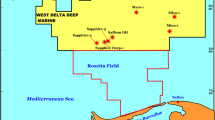Abstract
The Luliang and Baoshan basins of Yunnan Province are two small-sized continental oil/gas-bearing sedimentary basins, which were developed at the bases of the Carboniferous and Devonian systems during the Late Tertiary, covering an area of 325 km2 and 254 km2, respectively. Since the 1990s, there have been discovered small-sized natural gas pools in these two basins. The natural gases are composed mainly of hydrocarbon gases, with nonhydrocarbons accounting for less than 2%. Of the hydrocarbon gases, methane accounts for more than 99%, and the components above C2 account for less than 0.2%. On the basis of previous studies of geological background, the composition of natural gases and their carbon isotopic composition, it has been defined that these two gas pools are of bacterial origin. In this work we have comprehensively measured the carbon and hydrogen isotopic composition of natural gases from these two basins and have gone into the details of the mechanism of gas generation. The δ 13C1 values of natural gases from the Luliang Basin are within the range of −72.1‰–−73.3‰, and the δDCH 4 values, −242‰–−234‰, indicating that the bacterial gas generation is dominated by the way of CO2 reduction. It has been evidenced that under continental-facies fresh water conditions there did occur the CO2 reduction as a process of bacterial gas generation. The δ 13C1 values of natural gases from the Baoshan Basin are within the range of −62.5‰–−63.5‰, and the δDCH 4, values, −252‰–−260‰. These isotopic characteristics are fallen into transitional phase of acetate fermentation and CO2 reduction as defined by Whiticar et al. (1986). An important discovery in the Luliang Basin is the carbon isotopic composition of ethane of purely biogenetic origin, i.e., its δ 13C2 values are within the range of −61.2‰–−66.0‰. These carbon isotopic values have been reported for the first time in China. As compared to the δ 13C2 values of less than −55‰ for the two cases encountered previously in the world, a significant difference is that in the latter two cases there are obvious signs of contamination caused by ethane of thermal origin. So it cannot be ruled out that the light δ 13C2 values are the result of isotope fractionation of ethane of thermal origin. The δ 13C2 values of natural gases from the Luliang Basin are all less than −60‰, and there is almost no possibility that ethane of thermal origin migrated vertically and horizontally into gas pools within this basins. This demonstrates that in the Luliang Basin the ethane, whose δ 13C2 values are within the range of −61.2‰–−66.0‰, is of purely biogenic, hence providing scientific evidence that ethane can be produced by the bacterial process. This is an important discovery in natural science, and also provides clues to the comprehensive study of the mechanism of formation of ethane.
Similar content being viewed by others
References
Schoell M. Genetic characterization of natural gas. AAPG Bull, 1983, 67: 2225–2238
Rice D D, Claypool G E. Generation accumulation and resource potential of biogenic gas. Bull AAPG, 1981, 65: 5–25
Xu Y C, Shen P, Zhen J J, et al. Geochemical characteristics of low-evolved natural gases from small-sized basins. Chin Sci Bull (in Chinese), 1999, 44(8): 887–889
Schoell M. The hydrogen and carbon isotopic composition of methane from natural gases of various origins. Geochim Cosmochim Acta, 1980, 44: 649–661
Qi H F, Guan D S, Qian Y B, et al. The Forming Conditions of Biogases in China (in Chinese). Beijing: Petroleum Industrial Press, 1977. 55
Jenden P D, Kaplan I R. Origin of natural gases in Sacramento Basin, California. AAPG Bulletin, 1989, 73(4): 431–453
Mattavelli L, Ricchiuto T, Martinenghi C. Deep iosotopic light methane in northern Italy. Bacterial Gas, 1992, 121–132
Lewis S D, et al. Isotope compositions of gases in sediments from the Chile continental margin. In: Proceedings of the Ocean Drilling Program. Scientific Results, 1995, 141: 307–312
Hunt J M, Miller R J, Whelan J K. Formation of C4–C7 hydrocarbons from bacterial degradation of naturally occurring terpenoids. Nature, 1980, 288: 577–578
Vogel T M, Oremland R S, Kvenvolden K A. Low-temperature formation of hydrocarbon gases in San Francisco Bay sediment (Cakifornia). Chem Geol, 1983, 37: 289–298
Oremland R S, Whiticar M J, Strohmaier F E, et al. Bacterial ethane formation from reduced, ethylated sulfur compounds in anoxic sediments. Geochim Cosmochim Acta, 1988, 52: 1895–1904
Hong Y, Huang Y S. Preservation of lipid hydrogen isotope ratios in Miocene lacustrine sediments and plant fossils at Clarkia, northern Idaho, USA. Org Geochem, 2003, 34: 413–423
Li M W, Huang Y S, Mark O, et al. Hydrogen isotopic compositions of individual alanes as a new approach to petroleum correlation: case studies from the Western Canada Sedimentary Basin. Org Geochem, 2002, 32: 1387–1399
Xie S, Nott C J, Avsejs L A. Palaeoclimatic records in compound-specific δD values of a lipid biomarker in ombrotrophic peat. Org Geochem, 2000, 31: 1053–1057
Whiticar M J, Faber E, Schoell M. Biogenic methane formation in marine and freshwater environments—CO2 reduction vs. acetate fermentation—sotopic evidence. Geochem Cosmochim Acta, 1986, 50: 693–709
Whiticar M J. Carbon and hydrogen isotope systematics of bacterial formation and oxidation of methane. Chem Geol, 1991, 161: 291–314
Valentine D L, Chidthaisong A, Rice A, et al. Carbon and hydrogen isotope fractionation by moderately thermophilic methanogens. Geochim Cosmochim, 2004, 68(7): 1571–1590
Author information
Authors and Affiliations
Corresponding author
Rights and permissions
About this article
Cite this article
Xu, Y., Liu, W., Shen, P. et al. Carbon and hydrogen isotopic characteristics of natural gases from the Luliang and Baoshan basins in Yunnan Province, China. SCI CHINA SER D 49, 938–946 (2006). https://doi.org/10.1007/s11430-006-0938-8
Received:
Accepted:
Issue Date:
DOI: https://doi.org/10.1007/s11430-006-0938-8




